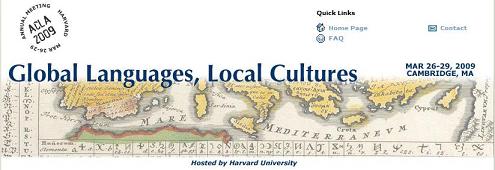Getting All
the Meaning In
Webpage heading for the
2009 meeting of the
American Comparative
Literature Association:
The mysterious symbols on
the above map suggest the
following reflections:
From A Cure of the Mind: The Poetics of Wallace Stevens, by Theodore Sampson, published by Black Rose Books Ltd., 2000–
Page x:
"… if what he calls 'the spirit's alchemicana' (CP [Collected Poems] 471) addresses itself to the irrational element in poetry, to what extent is such an element dominant in his theory and practice of poetry, and therefore in what way is Stevens' intricate verbal music dependent on his irrational use of language– a 'pure rhetoric of a language without words?' (CP 374)?"
| From "'When Novelists Become Cubists:' The Prose Ideograms of Guy Davenport," by Andre Furlani:
Laurence Zachar argues that Davenport's writing is situated "aux frontieres intergeneriques" where manifold modes are brought into concord: "L'etonnant chez Davenport est la facon don't ce materiau qui parait l'incarnation meme du chaos– hermetique, enigmatique, obscur, avec son tropplein de references– se revele en fait etre construit, ordonne, structure. Plus l'on s'y plonge, et plus l'on distingue de cohesion dans le texte." 'What astonishes in Davenport is the way in which material that seems the very incarnation of chaos– hermetic, enigmatic, obscure, with its proliferation of allusions– in fact reveals itself to be constructed, organized, structured. The more one immerses oneself in them the more one discerns the texts' cohesion.' (62). Davenport also works along the intergeneric border between text and graphic, for he illustrates many of his texts. (1) "The prime use of words is for imagery: my writing is drawing," he states in an interview (Hoeppfner 123). Visual imagery is not subordinated to writing in Davenport, who draws on the assemblage practice of superimposing image and writing. "I trust the image; my business is to get it onto the page," he writes in the essay "Ernst Machs Max Ernst." "A page, which I think of as a picture, is essentially a texture of images. […] The text of a story is therefore a continuous graph, kin to the imagist poem, to a collage (Ernst, Willi Baumeister, El Lissitzky), a page of Pound, a Brakhage film" (Geography 374-75). Note: (1.) Davenport is an illustrator of books (such as Hugh Kenner's The Stoic Comedians and The Counterfeiters) and journals (such as The Kenyon Review, Parnassus, and Paideuma). His art is the subject of Erik Anderson Reece's monograph, A Balance of Quinces, which reveals the inseparable relationship between Davenport's literary and pictorial work. References: Davenport, Guy. The Geography of the Imagination. San Francisco: North Point Press, 1981. Rpt. New York: Pantheon, 1992. Hoepffner, Bernard. "Pleasant Hill: An Interview with Guy Davenport." Conjunctions 24 (1995): 118-24. Reece, Erik Anderson. A Balance of Quinces: The Paintings and Drawings of Guy Davenport. New York: New Directions, 1996. Zachar, Laurence. "Guy Davenport: Une Mosaique du genres." Recherches Anglaises et Nord-Americaines 21 (1994): 51-63. |
"… when novelists become Cubists; that is, when they see the possibilities of making a hieroglyph, a coherent symbol, an ideogram of the total work. A symbol comes into being when an artist sees that it is the only way to get all the meaning in."
— Guy Davenport, The Geography of the Imagination

